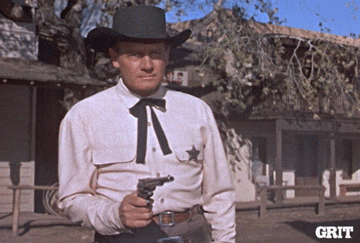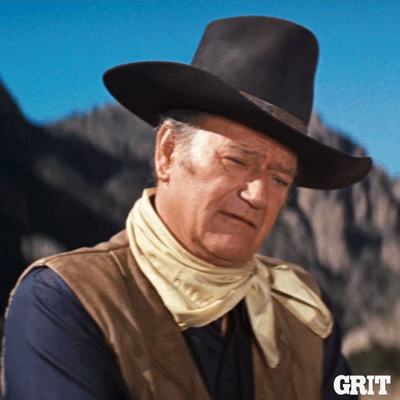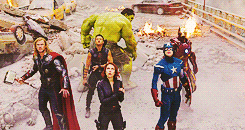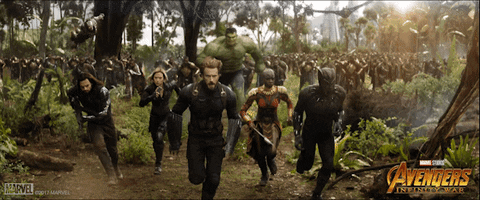As superhero films fare less and less at the box office, here’s an analysis of the possible reasons for the decline of this iconic genre of the 2000s, which follows the same trajectory as the late western.
Today, it is more than ever a question of questioning what is often summed up by a ready-made expression: “superhero fatigue”. This term, which we saw flourish in the early 2010s (even before the release of the first Avengers) was then used by critics of the genre to show their deep weariness with it.
After 25 years of superhero cinema (starting with Blade in 1998), there have been about 78 DC and Marvel superhero movies in theaters*, an average of three a year, and we’re not even talking about the boom in series adapted from comics, which we listed here and, despite a stoppage of the account in 2019, our article already had more than 80 entries!
Giphy
But in 2023, the superhero genre has suffered several setbacks: if Guardians of the Galaxy 3 achieved a score almost equivalent to its previous opus at the box office, Shazam 2, Blue Beetle, The Flash and Ant-Man 3 are complete plants. Concerns that another flagship genre of cinema has already experienced before it, which also experienced a golden age and a huge decline: the western.
When we read that the western genre has disappeared, we always think of recent counter-examples, whether they are called Hostiles, Les 8 Salopards, The Revenant or Les Frères Sisters, etc. But the fact is that the western is now a genre absent from cinemas, only rising from its grave occasionally with a strong subject and one or more stars to attract the public in theaters. But what happened to the western that could also happen – or has already happened – to superheroes?
The destiny of the western in (pony) express
The western is a genre almost as old as the cinema, since at the beginning of the 19th century, the daily life shown in westerns does indeed exist “in real life”, and Frank James – brother of the famous Jesse – like Wyatt Earp are still alive ! The first boom of the genre appeared at the end of the 1920s, with the arrival of talkies, which made it possible to hear gunshots and make cowboys sing!

Giphy
We will stick here to the American western, where the genre was divided into “A” movies (big budget movies), “B series” (low budget movies) and serials (stories divided into 13 episodes broadcast at the rate of one every Saturday morning). But with the arrival of the Great Depression, the public loses interest in these positive and heroic films, far from its considerations and its daily life.
It was John Ford who put the genre back in the spotlight in 1939 with The Fantastic Ride which, in addition to bringing John Wayne out of a nine-year purgatory of filming westerns without money, became a great success which stimulate interest. With the need for patriotic films during the Second World War, the western exploded again, offering two decades of very good films, drowned in a colossal mass of productions (54 westerns were released in 1958, or 28% of American films in the year).
The genre gradually disappeared following the arrival of television, which replaced serials, and the number of films declined at the end of the 1950s, only to explode on the small screen with Bonanza, Au nom de la loi, Rawhide, Le Virginian, Gunsmoke, Maverick, etc.,. From the 1960s, the western became one of the genres chosen for very expensive event films (The Cheyenne, The Conquest of the West), and former stars of the genre who still tried the adventure like Kirk Douglas or John Wayne.

Giphy
John Wayne
From the 70s until today, the genre remains limited to prestige films or direct-to-DVD / streaming.
Western and superheroes, same fight?
The 25 years of the genre can be divided according to us as follows:
- The Golden Age: Until Avengers (2012)
Whether it’s the first X-Men trilogy and even The Beginning, the first MCU films culminating with Avengers, which brought together many heroes, or even Sam Raimi’s Spider-man trilogy: spectators are amazed and measure what can now be accomplished in special effects. Fans finally see their heroes embodied on screen in a (relatively) respectful way.
All is not good of course (Catwoman, Blade III or even the two fantastic Four), but the public follows with enthusiasm.

Giphy
This period can be compared to that of the first years of the western: those where the public discovers its history revisited and the heroes without stain settle their account with the villains, even if they come from other planets! A way to reassure a post-9/11 America and, in the case of the western, post-World War I.
- After Avengers: the quality drops, but the saviors are there! (2013 – 2019)
The onset of weariness comes in the mid-2010s. It should be remembered that when Iron Man 2 was released, it had already been ten years since superhero films made a strong comeback with the trilogies of Sam’s Spider-Man Raimi and that of the X-Men. Spin-offs are starting to multiply, and Kevin Feige, boss of the Marvel Cinematic Universe, says he plans at least ten years of films if success continues to be there.
The series begin to multiply on TV, soon reinforced by streaming platforms who all want their share of the cake. Marvel and DC are having a blast: the genre is everywhere and with it, an audience drowned in productions, not all of which are watchable.

Giphy
As the western had had John Ford, the super-heroic genre has three providential men: James Gunn first, who restores oxygen to the spectators with his Guardians of the Galaxy, at a time when the films begin to skate (Avengers 2, Ant-Man, Thor 2), but especially the Russo brothers. By signing Captain America: The Winter Soldier, they became Marvel’s star directors, and public darlings with Avengers 3 and 4, which achieved considerable success.
At the same time, at DC, the failure of the release of Justice League is a disaster from which the brand’s cinematic universe will never really recover, despite great box office successes like Aquaman or Wonder Woman.
- Rebooting slowly: all for all from DC; the failure of the MCU? (2020 – present)
By multiplying the content and always more – by offering Marvel series on Disney+ that you must have followed to fully enjoy the MCU experience, and by cutting back on quality with increasingly average or even bland products or without links with the world of cinema, the public has moved away. The films have generally been shunned by the public, which has grown up and no longer has the same demands or the same wonder as ten years earlier.
For his part, James Gunn, who has become the big boss of DC on the screens, is about to release 5 new films and 5 DC series by starting the universe from scratch. A daring attempt in the current context of a box office in decline for this category of feature films.

Giphy
The time of innocence and discovery is gone and the superhero genre may be entering its “prestige” phase. As movies increasingly cost more to produce and Marvel has returned to the slow pace of two movies a year it had in its early days, perhaps the time for one-upmanship has become one for scarcity.
The genre is already beginning to rely on nostalgia to try to rekindle the flame. We are already recalling the glories of yesteryear via the concept of the multiverse: Patrick Stewart returns to play Professor X in Doctor Strange 2, Hugh Jackman puts on Wolverine’s claws for a Deadpool 3… Like in the days of the Italian western or pairing Django and Sartana needed to boost entries.
- The future: let’s play the guessers!
Zack Snyder is in favor, to save the genre from weariness, of opting for a reboot every ten years. James Gunn seems to have understood the parallel existing between superheroes and cowboys. When he says superhero fatigue is here on the podcast Inside of Youhe adds that the time is now for stories rooted in the reality of the characters and their emotions.
This fits perfectly with the history of the western, which was “psychologized” during the 1950s with titles like The Train will whistle three times or The Human Target, which offered complex and tortured heroes to bring novelty to a genre. marked out and rinsed by a delirious number of productions.

Giphy
The studios should be wary, however, because if this had attracted the public back to the genre by creating a new curiosity, it had inevitably led to a loss of interest because if it gave some of its masterpieces to the western, the genre has continued to decline because it was simply out of step with the times.
The super-heroic genre must deconstruct itself and do its self-analysis if it does not want to die. Otherwise, it risks in the more or less long term to enter the last phase, that of the recent years of the western that we know only too well, with a film every 5 years, when a star has the fad to try his hand at the genre or that a director thinks he has a story to tell**.
Perhaps Logan, the last solo part of the adventures of Wolverine, had already said everything? Regardless of the hero’s invincibility on screen, there comes a time when it’s time for him to die despite everything… to better be reborn one day from his ashes, because in Hollywood more than anywhere else, history is only an eternal restart.
* counting animated films adapted from this license such as “LEGO Batman” or “Spider-Man: New Generation”, but excluding “Hancock”, for example.
** A few series like 1883, Godless or The English tried the adventure recently, but often go unnoticed.
